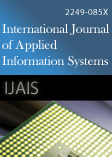
- Shanthini. A and Chandrasekaran. R. M 2013. Effect of Ensemble Methods for Software Fault Prediction at Various Metrics Level. International Journal of Applied Information Systems. 5, 2 (January 2013), 51-55. DOI=http://dx.doi.org/10.5120/ijais450853
-
@article{10.5120/ijais2017451568, author = {Shanthini. A and Chandrasekaran. R. M}, title = {Effect of Ensemble Methods for Software Fault Prediction at Various Metrics Level}, journal = {International Journal of Applied Information Systems}, issue_date = {January 2013}, volume = {5}, number = {}, month = {January}, year = {2013}, issn = {}, pages = {51-55}, numpages = {}, url = {/archives/volume5/number2/420-0853}, doi = { 10.5120/ijais12-450853}, publisher = { xA9 2012 by IJAIS Journal}, address = {} } -
%1 450853 %A Shanthini. A %A Chandrasekaran. R. M %T Effect of Ensemble Methods for Software Fault Prediction at Various Metrics Level %J International Journal of Applied Information Systems %@ %V 5 %N %P 51-55 %D 2013 %I xA9 2012 by IJAIS Journal
Abstract
Defective modules in software project have a considerable risk. It reduces the software quality. Defective modules decreases customer satisfaction and by increases the development and maintenance costs. In software development life cycle, it is very essential to predict the defective modules in the early stage so as to improve software developers' ability to focus on the quality of the software. Software defect prediction using machine learning algorithms was investigated by many researchers and concluded that classifiers ensemble can effectively improve classification performance than a single classifier. This paper mainly addresses the software fault prediction using ensemble approaches. We conduct a comparative study using WEKA tool for various ensemble methods with perspective of taxonomy. The ensemble methods include Bagging, Boosting, Stacking, and Voting. We also compared these ensemble methods for three different levels of software metrics (Class level, Method level and Package level). Ensemble classifiers were examined for various metrics level datasets. Various ensemble classifiers were examined for three different metrics levels. The experiments were carried out on the datasets such as NASA KC1 method level data set, NASA KC1 class level dataset and Eclipse dataset for package level metrics. The experiments conducted on these three data sets by applying ensemble classification methods to predict defect. The ensemble methods evolved by experiments shows that bagging performs better than other ensemble methods for method level and package level dataset. For class level dataset voting performs better in terms of Area under ROC curve (AUC – ROC).
References
- I. H. Witten and E. Frank, Data Mining: Practical Machine Learning Tools and Techniques with Java Implementation, Morgan Kaufmann, 2005.
- Knab, P. , Pinzger, M. , and Bernstein, A. , 2006. "Predicting defect densities in source code files with decision tree learners," in the 2006 International Workshop on Mining Software Repositories.
- H. Zhang and X. Zhang, Comments on "Data Mining Static Code Attributes to Learn Defect Predictors", IEEE Trans. on Software Eng. , Vol. 33(9), Sep 2007
- Sandhu, Parvinder Singh, Sunil Kumar and Hardeep Singh, 2007 "Intelligence System for Software Maintenance Severity Prediction",Journal of Computer Science, Vol. 3 (5), pp. 281-288.
- Catal, C. , Diri, B. , and Ozumut, B. , 2007. "An Artificial Immune System Approach for Fault Prediction in Object-Oriented Software," in 2nd International Conference on Dependability of Computer Systems DepCoS-RELCOMEX.
- Menzies, T. , Greenwald, J. , & Frank, A. (2007). Data mining static code attributes to learn defect predictors. IEEE Transactions on Software Engineering, 33(1),
- Olague, H. M. , Etzkorn, L. H. , Gholston, S. , Quattlebaum, S. , 2007. Empirical validation of three software metrics suites to predict fault-proneness of object-oriented classes developed using highly iterative or agile software development processes. IEEE Transactions on Software Engineering 33 (6), 402– 419.
- S. Kanmani, V. R. Uthariaraj, V. Sankaranarayanan, P. Thambidurai, Objected-oriented software fault prediction using neural networks, Information and software Technology 49 (5 (2007)) 483 – 492.
- Dr Kadhim M. Breesam, "Metrics for Object Oriented design focusing on class Inheritance metrics", 2nd International conference on dependability of computer system IEEE, 2007.
- K. O. Elish, M. O. Elish, Predicting defect-prone software modules using support vector machines, Journal of Systems and Software 81 (5) (2008) 649– 660.
- I. Gondra, Applying machine learning to software fault-proneness prediction, Journal of System and Software 81(2) (2008) 186-195.
- Amjan Shaik, Dr C. R. K. Reddy, Dr A Damodaran, "Statistical Analysis for Object Oriented Design Software security metrics", International journal of engineering and technology, Vol. 2, pg 1136-1142. 2010
- Software fault prediction: A literature review and current trends Cagatay Catal, Expert Systems with Applications 38 (2011) 4626 – 4636.
- T. Dietterich. An experimental comparison of three methods for constructing ensembles of decision trees: bagging, boosting, and randomization. Machine Learning, vol. 40, No. 2, pages 139 – 157,
- Tsoumakas, G. , Katakis, I. and Vlahavas, I. "Effective Voting of Heterogeneous Classifiers", In Proceedings of the 15th European Conference on Machine Learning, Italy, pp 465-476.
Keywords
Defect prediction, Classifier Ensemble; Ensemble Methodology
 10.5120/ijais12-450853
10.5120/ijais12-450853
